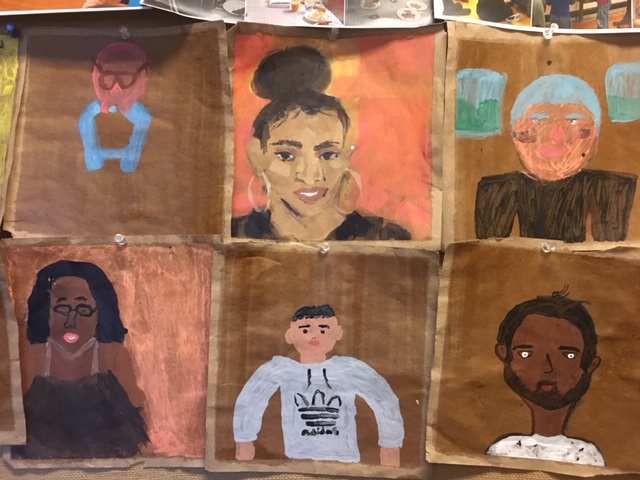
The “I Learn America” Project: Vassar College and Migrant Narratives from Poughkeepsie, NY

This is part of our special feature on forced migration, Narration on the Move.
This is part of our campus spotlight on Vassar College.
For too many years now, millions of uprooted children and young people have fallen between the cracks, unseen among the data. Not only do they face discrimination and isolation as they seek to make new lives for themselves, but many do not have access to national or local services, and are never accounted for by the various child-protection systems as they cross borders. Indeed, data is scarce, and little is known about these individuals’ health, their education, and how migration is affecting their futures. Unprecedented numbers of these children and young people are arriving in Poughkeepsie, New York, having come from Mexico or Central America. The students have traveled to the United States either on their own or with one family member. They have made difficult journeys through Mexico, and at the US border, they have made themselves known to the authorities. Many of these newcomers have spent some time in detention at the border. Some were separated from adult caregivers either during the journey or upon their arrival in this country, and others are unaccompanied minors. Their living arrangements and degree of family support vary widely, from those who benefit from established networks to those who have more fragile family contexts. This situation exacts a heavy emotional toll on adolescents who must learn a foreign language, adapt to a new community, live with family members whom they may not have seen for many years or have never met before, adjust to a new climate, navigate the loss of relationships back home, and deal with the trauma of the immigration process itself.
In recent years, immigrants have been the fastest-growing population within the Poughkeepsie City School District. Unfortunately, there is no formal newcomer program at Poughkeepsie High School (PHS), not even anyone at PHS in charge of welcoming newcomers. Vital information, such as classes offered, expectations for graduation, and policies such as attendance, transportation, and other school rules, is not standardized and hard to come by. The immigrant students experience poor attendance, uneven participation, and higher-than-average dropout rates. All of this carries enormous risks. Outside of school, these children are unlike other students because owing to their irregular status and the language barrier, they are not on the radar screen of the social service agencies. The specific risks include exposure to forced labor; early pregnancy; violence; gang recruitment; bullying; trafficking; and use of illicit drugs; and sheer neglect.
The I Learn America project is one of several local initiatives that some of us at Vassar College are undertaking in response to the global phenomenon of forced migration, via funding provided by the Consortium on Forced Migration, Displacement, and Education. The project is conceived along the same philosophical lines as the Consortium: i.e., the belief that experiential learning is essential, and that by working on real problems such as forced migration in tandem with those directly affected by these issues we can prepare our undergraduates to become, after graduation effective advocates for greater justice and opportunity in the world.
At the core of the I Learn America project is a recognition that recently-arrived children need an educational curriculum that addresses not only language-development but also identity, culture, and social and emotional health. The project’s proponents believe that school officials must be well-informed of the needs and backgrounds of their students if they are to help them adjust to a new country, language, and customs. Teaching staff should be highly trained in cross-cultural communication, the specific cultural and historical backgrounds of the students, and instructional methods designed to accelerate their academic achievement. This project began when a group of Vassar College students and faculty members shared their interest in supporting newcomer students, and even more so, the teachers who work with those students. The group decided that any effective program to address the needs of child migrants would have to be based upon a start from a much better understanding of the children’s lives, including their perceptions of these.
The I Learn America project, co-led by Dillon Paul, the ENL teacher at Poughkeepsie High School, and Tracey Holland of Vassar College engages immigrant students to tell their stories through a variety of mediums including writing, podcasting, and the making of visual art. The project takes its name from the documentary film I Learn America (2013) by Jean-Michel Dissard and Gitte Peng. The film follows five teenagers as they strive “to master English, adapt to families they haven’t seen in years, and create a future of their own while coming of age in a new land.” Since the release of the film students all around the world with opportunities to share their stories, create and engage in dialogue and make connections both social and intellectual. Students at Poughkeepsie High School have been paired with students at Vassar College to support the writing process, share life experiences, and forge mentoring relationships. During the Spring semester of 2019, the pairs met several times at the high school in order to develop ideas. The collaboration led to a day trip to Vassar College, where student stories were recorded in the college’s audio recording studio. These stories have been edited and shared on the I Learn America website in both written and audio formats. While the project began as an effort to help the Vassar students better understand the PHS students’ needs, it has blossomed into a project that has given the latter an opportunity to tell their stories and to be part of a national—and even global—conversation about immigration that is actively led by immigrant young people.
In Europe, numerous projects are having a meaningful impact on the migration crisis by allowing migrants to tell their own stories. Four that come to mind are: “Read my story – hear my voice: refugees’ contribution to democratic citizenship” a project implemented by the network Voices of Young Refugees in Europe, “The Archive of Migrant Memories;” “Moving Voices;” and “Refugee Radio Network.” We feel privileged to be helping students in Poughkeepsie raise their voices and participate in this larger movement.
Thus far, fourteen unique stories have been created by and with students at Poughkeepsie High School. These stories provide us with nuanced understandings of their lived experiences, including both the experiential, subjective ways in which they view the world and a sense of the external forces and power dynamics impacting their movements. There is not sufficient space to share the rich detail of these stories, but some commonalities do emerge that were raised in an initial workshop for the PHS teachers in May 2019. The ensuing stories and themes give a vivid sense of the challenges faced by these students and their families.
One fifteen-year-old from Guatemala whom we shall call Yerny lived alone from the time he was twelve until he arrived in the United States at fifteen and was reunited with his mother. After his mother left and his grandmother died, Yerny went to live first with his stepmother, then his aunt, and finally his older brother. When the brother married, Yerny at twelve years old began to live on his own. He left school when he was eleven because “nobody made [him] go to school.” Another student from the Dominican Republic, Desi, was unable to leave her home without being accompanied by a family member, because the conditions in her hometown were too violent to allow her to walk outside alone. Thus, Desi, would often miss school if no one was available to serve as her escort.
All of these students report having come from extremely poor households, located chiefly in rural regions of Honduras and Guatemala. Several of them said their houses were made of wood and mud, having dirt floors and straw roofs. Margarita’s family did not have electricity, and the bathroom was an outhouse. In 2014, when she was eleven and in the sixth grade, she left school. She began to spend her time helping her mother at the milpa, a small field where people grow their crops for consumption. They would cook lunch and bring it to her brothers and other family members, and to other people who were working in the corn and bean fields. Everyone in the community worked. Sometimes Margarita also would help to plant or harvest the corn and beans in the fields.
Some students reported having to work to help their families, owing to the illness or injury of an adult breadwinner. David left school when his father broke both legs in a car accident and was thereby rendered unable to work for two and a half years. Devon told the sad story of his younger brother’s death. Devon was eleven and working out on a farm; there was no phone in his home so the news did not arrive until after his brother had died of diarrhea, an illness that could easily have been treated if the family had had the money to pay hospital fees. Filled with guilt because he was not there when his brother died, Devon left school and spiraled downward into locura, or insanity. His brother had been his best friend, and they were always together.
Most of the students had, as per their self-reports, stopped attending school in their home countries between the ages of twelveand fourteen, and most reported completing six years or less of primary school. Most of them never even began, much less completed, secondary school in their home countries. Schooling was interrupted by family factors (such as moves), by school ones (strikes), by environmental ones (the floods of the rainy season), and by financial ones (not being able to afford the transportation costs of attending a distant secondary school). And even when students completed their grade that does not mean they acquired the knowledge associated with its curriculum. Teacher absences, school closures, and student absences were the norm in the experiences of these students. In some cases the gaps reflect students’ evaluations of their priorities; decisions they were forced to make so as to ensure their own safety; or forces beyond their control.
These students come from socioeconomically marginal areas, places where education is heavily and adversely affected by loss of teachers and by inadequate or nonexistent educational infrastructure. In Margarita’s case there was just one primary school to serve the needs of all the kids in her rancho or camp for tenant farmers, and the closest secondary school was a three hour walk away. One teacher, who daily came on foot from another town, taught everyone within one classroom. The teacher did not show up every day, and many of the students spoke about how frequent school closings and spotty faculty attendance made it hard for them to keep up, or even to engage with, their lessons. They mentioned the limited availability of free secondary education and vocational training, as well as frequent teacher strikes. As a result, these students have suffered, at least in the short term, from the interruption of schooling in their home countries, and it is not surprising that they left first the schools and then their countries.
One remarkable student whom we will call Wilson explained that he left school during third grade and went to work on a cattle farm. Now he knows a lot about how to “fatten up the cows” and about the specific hormones used by farmers. When another student, known as Delberto, left school in Guatemala at age twelve, he went to work making and selling the dulcitas (treats) known as miel de caña, candy made from sugar cane syrup. He said he learned how to make it and sell it in Esquipulas, the larger town next to his hometown. We were touched when Delberto said that he can’t find miel de caña in Poughkeepsie but knows he can always get it in the nearby town of Brewster.
All of the students could remember one teacher in their home country who positively impacted them and from whom they learned. A Guatemalan student described her sixth-grade teacher as being a woman who “liked being out in the gardens with the flowers” and whose presence made the environment “bien bonita,” or “truly pleasing.” A student from Mexico talked about a teacher who would sing and act out her lessons, always making “an effort to make us students laugh. ” The most striking description of a teacher came from another Guatemalan student: “In seventh and eighth grades, all the teachers went on strike, but one teacher remained at the school and continued to teach. ” That teacher taught three grades, reinstituted a computer program, and organized clubs for them. The student said that having a teacher who worked so hard made him feel cared for. He ended the interview by sharing the sad fact that eventually, the teacher received “death threats” and had to leave the community. The student was upset that the teacher had to leave, but he remains impressed by his resiliency.
A common theme that recurred in these students’ narratives is that of forgotten lessons. One student studied mathematics in Honduras, learning to add, subtract, multiply, and maybe divide. He says he cannot do any of those operations now because he has forgotten how to do so. As for Delberto, during his last three years in his home country he was not in school–never, he says, studying or even reading (sin leer) during that time.
All of the students without exception expressed their aspirations for better living conditions and brighter educational prospects. A significant factor motivating their migration was their desire to access educational opportunities they otherwise would not have been privy to, thereby facilitating further overall attainment. And yet the stories also reveal that many of the students are struggling to cope with separation from their parents and siblings, many of whom still live in their home countries. Over and over again we heard such simple statements as “I miss my mom so much! She is so sad without me!” Indeed, several of the students were experiencing a pervasive longing “to see my mom.”
Most of the accounts of PHS were good, with only a couple of students describing issues they have with the school. Once they had arrived in Poughkeepsie, some students said they did not enter school immediately because they did not have the correct paperwork. Eventually, however, all of the students we interviewed did enter the 9th grade, regardless of their age. In order to make it through lessons imparted in a language he generally does not understand, Marco turned to copying other students’ work as a survival skill. The students we interviewed seem to struggle the most in science, for the explanations are given in English, and they don’t understand what is going on. In general, they find it problematic that the exam questions are in Spanish, but the explanations are in English. Translated school materials are helpful for some students, but students like Eduardo do not read very well even in Spanish, so for them those aren’t much help. The students enjoy History the most, because the teacher makes them laugh and is very patient. She always makes sure the Spanish-speaking students understand what is going on in class, even though they still struggle. Many students share their appreciation of certain PHS teachers for taking the extra time needed to explain a topic or bring them a laugh during a hard lesson. One student said that the support he “received from teachers from the first day has helped him to feel welcome at PHS.”
Despite the overwhelming trauma and the interruption and isolation that most of these students have had to endure at such an early age, at their core these young people crave the same things as every other student at Poughkeepsie High School: security, a family, a future. All of the students told us they want to finish school and to work. Eduardo aspires to be a teacher, saying, “Many people like me need help… everybody needs help!” Many students shared their desire to “learn more English,” a skill so fundamental to their future success in this country. They all want to do so as quickly as possible, and thus they worry about the insufficient opportunities to learn English during the school day.
Throughout 2019 and2020, the project will continue and grow, as more of PHS students write, revise, and record their stories. It will be left up to the students themselves whether they want to submit their written stories for possible inclusion in the I Learn America website–or they may choose to share their written work more privately with friends, family, and teachers. Students also will be given opportunities to create podcasts, audio-recordings, and Story Maps. Storytelling projects focused on youth participation and empowerment constitute a growing movement all around the world that is allowing anyone who is interested to learn about the complex first-hand experiences of children and young people who have left their homes and are seeking new ones.
Tracey Holland is a faculty member in the Latin American/Latinx Studies Program at Vassar College in Poughkeepsie, NY. Tracey earned her MA in International Education from Teacher College, Columbia University and her Ph.D. in International Education from New York University. Tracey’s research focuses on human rights education, peacebuilding, migration, and children’s rights.
Photo:
Published on October 29, 2019.




